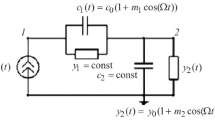Abstract
We consider methods to construct mathematical models for the automation of circuit design that implement the calculations of the parameters and the structure of the circuit connections of the components of the developed electronic device displayed by its graphic scheme. We note that the modeling of frequency properties of an electronic circuits in a frequency range is among the main problems of circuit design. Within this range, the frequency characteristics of the circuit are computed multiply to find the admissible or optimum values of the parameters of the components used in the designed electronic circuit. It is shown that two approaches to resolve such a problem are possible. The first approach is based on the description of the simulated circuit by complex matrices at each frequency f [kf] of the given frequency range with the preliminary calculation of the operator s = (0.0, 2 × 3.14 f [kf]). A substantial disadvantage of this approach is the necessity to form a mathematical description of all the circuit components at each frequency. The second approach is based on the representation of the complex matrix of the scheme in the bilinear form W = A + sB, where A and B are real frequency-independent matrices. It is shown that, in a number of cases, we have to present the equations of frequency-dependent components in an explicit form to implement such an approach, while this is possible only if the scheme is described in selected coordinate bases such that this possibility is foreseen for them. A technique is proposed to describe the simulated circuits based on a modified basis of the nodal potentials, providing the possibility to use both explicit and implicit forms to specify the component equations. It is shown that the bilinear form of the circuit description, based on the modified basis, substantially improves the efficiency of computing the frequency characteristics because the fixed frequency-independent matrix components of the circuit are used at each frequency.


Similar content being viewed by others
REFERENCES
V. P. Sigorskij and A. I. Petrenko, Electronic Circuit Analysis Algorithms (Sov. Radio, Moscow, 1976) [in Russian].
I. P. Norenkov, Introduction to Computer-Aided Design of Technical Devices and Systems (Vyssh. Shkola, Moscow, 1986) [in Russian].
B. A. Kalabekov, I. YU. Lapidus, and V. M. Malafeev, Methods of Automated Calculation of Electronic Circuits in Communication Technology (Radio Svyaz’, Moscow, 1990) [in Russian].
B. V. Batalov, Yu. B. Egorov, and S. G. Rusakov, Fundamentals of Mathematical Modeling of Large Computer Integrated Circuits (Radio Svyyaz’, Moscow, 1982) [in Russian].
E. L. Gloriozov, V. K. Sorin, and P. P. Sypchuk, Introduction to Circuit Design Automation (Sov. Radio, Moscow, 1976) [in Russian].
A. I. Petrenko and O. I. Semenkov, Fundamentals of Building Computer-Aided Design Systems (Vyssh. Skola, Kiev, 1984) [in Russian].
G. Forsyte, M. Malkolm, and C. Moler, Computer Methods for Mathematical Computation (Prentice Hall, NJ, 1977).
O. Osterby and Z. Zlatev, Direct Methods for Sparse Matrices (Springer, New York, 1983).
N. F. Il’inskij and V. K. Cacenkin, Application of Graph Theory to Problems of Electromechanics (Energiia, Moscow, 1968) [in Russian].
L. Robichaud, M. Boisvert, and J. Roert, Graphes de fluense. Applications a l’electrotechnique et a l’electronique (Canade, 1961).
G. Kron, Diacoptics (Macdonald, London, 1970).
Yu. V. Timkin, Bidirectional Graph Analysis of Electronic Circuits (Energoatomizdat, Moscow, 1985) [in Russian].
V. N. Il’in, Fundamentals of Automation Circuit Design (Energiia, Moscow, 1979) [in Russian].
I. P. Norenkov and V. B. Manichev, Computer-Aided Design Systems for Electronic and Computing Equipment (Vyssh. Shkola, Moscow, 1983) [in Russian].
Y. Vlach and K. Singhal, Computer Methods for Circuit Analysis and Design (VNR, New York, 1983).
L. Chua and Pen-Min Lin, Computer-Aided Analysis of Electronic Circuits (Prentice Hall, New York, 1980).
J. Fidler and C. Nightingale, Computer Aided Circuit Design (Wiley, New York, 1980).
G. V. Obrezkov et al., Applied Mathematical Methods of Analysis in Radio Engineering (Vyssh. Shkola, Moscow, 1985) [in Russian].
A. Troelsen, PRO C#2005 and the. NET 2.0 Platform (Apress, 2005).
V. N. Gridin, N. G. Ryzhov, V. I. Anisimov, and M. M. Abuhazim, “Methods to boost performance modeling of dynamic modes of nonlinear systems,” Inform. Tekhnol., No. 11, 796–802 (2017).
Author information
Authors and Affiliations
Corresponding author
Ethics declarations
The authors declare that they have no conflict of interest.
Additional information
Translated by A. Muravnik
Rights and permissions
About this article
Cite this article
Gridin, V.N., Anisimov, V.I. Increased Efficiency of Systems Modeling Electronic Circuits in Frequency Domains. Math Models Comput Simul 11, 859–866 (2019). https://doi.org/10.1134/S2070048219060085
Received:
Revised:
Accepted:
Published:
Issue Date:
DOI: https://doi.org/10.1134/S2070048219060085




